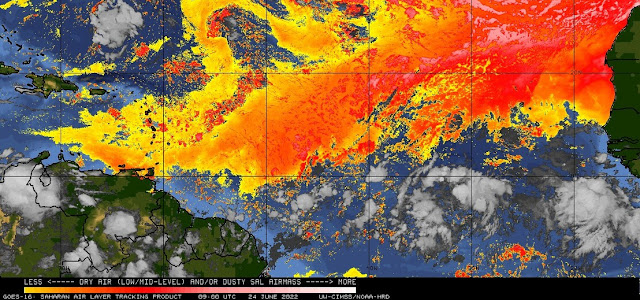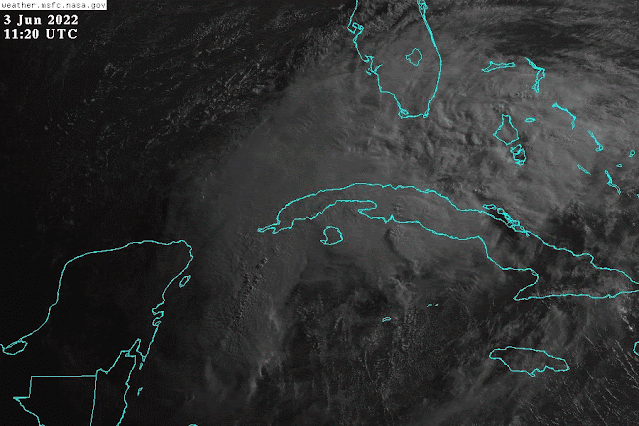The tropical disturbance that I mentioned in Friday's update has gotten better organized, but is still not a tropical cyclone. Although it contains tropical storm force winds, it's lacking a coherent circulation at the surface. Once named, it would be Bonnie.
On Monday evening, the designation switched from Invest 94L to Potential Tropical Cyclone (PTC) Two. This PTC nomenclature was introduced in 2017 (first used on June 18, 2017 for future-Bret), and has caused some confusion. A PTC and an Invest are the same thing: an area of interest that has not yet become a tropical cyclone. But, there are instances where an Invest is approaching land and is expected to develop within the next day or two, warranting the issuance of watches and/or warnings. This was not possible using NHC's existing Invest framework, so the PTC framework was created. Now, advisories, watches, and warnings can be issued for an Invest if needed using the PTC mechanism. Think of it as a software hack rather than a change in the status of the storm system. Prior to 2017, this exact same system would still be called Invest 94L.
It's cruising along very far south... it has not been above 10°N since it left the African coast last Tuesday. This is expected to continue, and the forecast keeps it hugging the northern coasts of Venezuela and Colombia through the next three days then making landfall in Nicaragua or Costa Rica sometime around Saturday -- possibly as a hurricane.
It will track directly over Trinidad on Tuesday night, most likely as a tropical storm. Trinidad and Tobago rarely get hit by tropical storms; the last three were Gonzalo (2020), Bret (2017), and Joyce (2000). They do get scraped by hurricanes passing by to the north now and then too. Then, the ABCs (Aruba, Bonaire, Curacao) will experience some impacts from this on Wednesday into Thursday.
It should be close enough to land to prevent much intensification. However, there is a brief window of about 36 hours between Colombia and Nicaragua when it could strengthen and perhaps reach hurricane intensity.
There are long radar loops from Guyana and Barbados available at http://bmcnoldy.rsmas.miami.edu/tropics/radar/, and one from Curacao will be added shortly. Unfortunately, the radar on Trinidad is down.
Elsewhere, the basin is stirring with an abnormal amount of activity for late June. A disturbance tagged as Invest 95L is in the northern Gulf of Mexico, and then there's an easterly wave right on to the tail of PTC2. Both have a low probability of becoming a tropical depression, but are worth watching.
NHC is giving the Gulf one (Invest 95L) a 30% probability of becoming at least a tropical depression by Thursday, but even if nothing happens with it, it will bring much-needed heavy rain into eastern Texas and southern Louisiana. This map shows the forecast rainfall accumulations through the weekend. Assuming PTC2 takes the name Bonnie, should this happen to become a tropical storm, the next name would be Colin.
- Visit the Tropical Atlantic Headquarters.
- Subscribe to get these updates emailed to you.
- Follow me on Twitter














